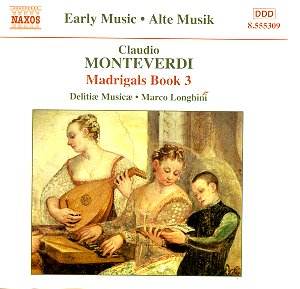In 1587 Duke Guglielmo
Gonzaga of Mantua died, and was succeeded
by his son Vincenzo I. This resulted
in a drastic change of the cultural
climate at the court. Whereas Guglielmo
had a rather conservative taste, Vincenzo
was open to the modern trends in music.
Vincenzo was in close contact with the
courts of Florence and Ferrara, in particular
since his sister married to Duke Alfonso
II d'Este of Ferrara and he married
Leonor' de Medici from Florence in 1584.
In around 1590 Monteverdi
arrived in Mantua, where he started
to be active as a madrigal singer. In
1592 he published his Third Book of
Madrigals, which shows the traces of
the new climate at the Mantuan court.
One of these is the use of texts by
Tasso and Guarini, the two famous poets
with whom Vincenzo became friends in
Ferrara. The second is that in some
madrigals there are extensive passages
for the three top voices, perhaps a
reference to the famous 'Concerto delle
Damme' which was active at the Ferrarese
court, and which Vincenzo greatly admired
and wished to copy at his own court.
In a number of madrigals
of the third book Monteverdi points
in the direction of the 'seconda prattica',
in particular in the two cycles 'Vattene
our, crudel' and 'Vivrò fra i
miei tormenti' which contain a number
of strongly declamatory passages. This
forward-looking character of the third
book could explain its popularity: thirty
years after its first appearance it
was still reprinted, which is remarkable
in a time of fast-changing tastes.
The book opens with
a rather moderate madrigal, which is
considered a tribute to the man the
book was dedicated to: Vincenzo I. The
reason for this is obvious: Giaches
de Wert, 'maestro di cappella' at the
ducal chapel of Santa Barbara was regularly
ill, and Monteverdi was hoping to succeed
him.
Some madrigals are
very virtuosic, in particular those
which contain passages for the three
upper voices. There is a lot of madrigalism
and chromaticism and dissonances are
used to illustrate parts of the text
as well as shifts in tempo.
The performance by
the ensemble Delitiae Musicae does full
justice to the imaginative settings
by Monteverdi. Last year I became acquainted
with this group's interpretations of
Monteverdi's madrigals, and I was enthralled
by the recording of the second book.
I can be just as enthusiastic about
the present disc: the change in the
top of the ensemble since then - the
alto Paolo Costa has been replaced by
Fabian Schofrin - hasn't changed the
fine sound of the ensemble as a whole.
In the booklet Marco Longhini quotes
additional support for his decision
to use only male voices for his recordings.
Another feature which
sets this performance apart from most
others is the use of instruments. Whereas
in the second book the ensemble included
a 'basso di viola', two lutes and a
harpsichord, here only a theorbo and
a harpsichord are used in some of the
madrigals. They provide a 'basso seguente'
accompaniment. The original publication
didn't contain a 'basso continuo' part;
this was only added in the publication
of the third book by Phalèse
in Antwerp in 1615.
As far as I am concerned,
the recordings of Monteverdi's madrigals
by Delitiae Musicae belong to the best
available. Hopefully the ensemble will
be able to record the remaining books
in due course.
Johan van Veen
see also review
by Gary Higginson


